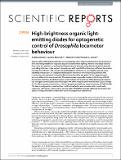Files in this item
High-brightness organic light-emitting diodes for optogenetic control of Drosophila locomotor behaviour
Item metadata
| dc.contributor.author | Morton, Andrew | |
| dc.contributor.author | Murawski, Caroline | |
| dc.contributor.author | Pulver, Stefan | |
| dc.contributor.author | Gather, Malte Christian | |
| dc.date.accessioned | 2016-08-04T09:30:11Z | |
| dc.date.available | 2016-08-04T09:30:11Z | |
| dc.date.issued | 2016-08-03 | |
| dc.identifier | 244482552 | |
| dc.identifier | ac56ffa0-f48c-4d01-aaa7-abb8a68975ba | |
| dc.identifier | 84981745035 | |
| dc.identifier | 000380652000001 | |
| dc.identifier.citation | Morton , A , Murawski , C , Pulver , S & Gather , M C 2016 , ' High-brightness organic light-emitting diodes for optogenetic control of Drosophila locomotor behaviour ' , Scientific Reports , vol. 6 , 31117 . https://doi.org/10.1038/srep31117 | en |
| dc.identifier.issn | 2045-2322 | |
| dc.identifier.other | ORCID: /0000-0002-4857-5562/work/47136466 | |
| dc.identifier.other | ORCID: /0000-0001-5170-7522/work/69463430 | |
| dc.identifier.uri | https://hdl.handle.net/10023/9255 | |
| dc.description | We thank Simone Lenk and Tobias Günther (TU Dresden) for fruitful discussions and technical support with OLED preparation. We are grateful for financial support from the Scottish Funding Council (through SUPA), Human Frontier Science Program (RGY0074/2013), Wellcome Trust Institutional Strategic Support Fund St Andrews and the RS Macdonald Charitable Trust. C.M. acknowledges funding by the European Commission through a Marie Sklodowska-Curie Individual Fellowship (703387). | en |
| dc.description.abstract | Organic light emitting diodes (OLEDs) are in widespread use in today’s mobile phones and are likely to drive the next generation of large area displays and solid-state lighting. Here we show steps towards their utility as a platform technology for biophotonics, by demonstrating devices capable of optical controlling behaviour in live animals. Using devices with pin OLED architecture, sufficient illumination intensity (0.3 mW.mm-2) to activate channelrhodopsins (ChRs) in vivo was reliably achieved at low operating voltages (5 V). In Drosophila melanogaster third instar larvae expressing ChR2(H134R) in motor neurons, we found that pulsed illumination from blue and green OLEDs triggered robust and reversible contractions in animals. This response was temporally coupled to the timing of OLED illumination. With blue OLED illumination, the initial rate and overall size of the behavioural response was strongest. Green OLEDs achieved roughly 70% of the response observed with blue OLEDs. Orange OLEDs did not produce contractions in larvae, in agreement with the spectral response of ChR2(H134R). The device configuration presented here could be modified to accommodate other small model organisms, cell cultures or tissue slices and the ability of OLEDs to provide patterned illumination and spectral tuning can broaden their utility in optogenetics experiments further. | |
| dc.format.extent | 8 | |
| dc.format.extent | 985519 | |
| dc.language.iso | eng | |
| dc.relation.ispartof | Scientific Reports | en |
| dc.subject | QH301 Biology | en |
| dc.subject | QC Physics | en |
| dc.subject | DAS | en |
| dc.subject.lcc | QH301 | en |
| dc.subject.lcc | QC | en |
| dc.title | High-brightness organic light-emitting diodes for optogenetic control of Drosophila locomotor behaviour | en |
| dc.type | Journal article | en |
| dc.contributor.sponsor | European Commission | en |
| dc.contributor.sponsor | Human Frontiers Science Programme | en |
| dc.contributor.sponsor | The Wellcome Trust | en |
| dc.contributor.institution | University of St Andrews. School of Physics and Astronomy | en |
| dc.contributor.institution | University of St Andrews. School of Psychology and Neuroscience | en |
| dc.contributor.institution | University of St Andrews. Biomedical Sciences Research Complex | en |
| dc.identifier.doi | https://doi.org/10.1038/srep31117 | |
| dc.description.status | Peer reviewed | en |
| dc.identifier.grantnumber | 703387 | en |
| dc.identifier.grantnumber | RGY0074/2013 | en |
| dc.identifier.grantnumber | 204821/Z/16/Z | en |
This item appears in the following Collection(s)
Items in the St Andrews Research Repository are protected by copyright, with all rights reserved, unless otherwise indicated.

